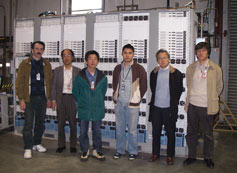
Handy Links
SLAC News Center
SLAC Today
- Subscribe
- Archives: Feb 2006-May 20, 2011
- Archives: May 23, 2011 and later
- Submit Feedback or Story Ideas
- About SLAC Today
SLAC News
Lab News
- Interactions
- Lightsources.org
- ILC NewsLine
- Int'l Science Grid This Week
- Fermilab Today
- Berkeley Lab News
- @brookhaven TODAY
- DOE Pulse
- CERN Courier
- DESY inForm
- US / LHC
SLAC Links
- Emergency
- Safety
- Policy Repository
- Site Entry Form

- Site Maps
- M & O Review
- Computing Status & Calendar
- SLAC Colloquium
- SLACspeak
- SLACspace
- SLAC Logo
- Café Menu
- Flea Market
- Web E-mail
- Marguerite Shuttle
- Discount Commuter Passes
-
Award Reporting Form
- SPIRES
- SciDoc
- Activity Groups
- Library
Stanford
Around the Bay
Helping to Power the Future
 SLAC made a key contribution to the next generation of linear accelerators this month with the delivery of 38 innovative power supplies to KEK in Japan. The power supplies will be installed in the
Accelerator Test Facility 2 (ATF2) now under construction there. The ATF2 is a test facility to demonstrate a novel design for focusing a beam down to the very small size needed at the collision point of a linear collider. The goal for
the ATF2 is to squeeze the beam to a size of tens of nanometers, about 0.1 percent of the diameter of a human hair.
SLAC made a key contribution to the next generation of linear accelerators this month with the delivery of 38 innovative power supplies to KEK in Japan. The power supplies will be installed in the
Accelerator Test Facility 2 (ATF2) now under construction there. The ATF2 is a test facility to demonstrate a novel design for focusing a beam down to the very small size needed at the collision point of a linear collider. The goal for
the ATF2 is to squeeze the beam to a size of tens of nanometers, about 0.1 percent of the diameter of a human hair.
Because the ATF2 is a stepping stone toward the planned International Linear Collider (ILC), the power supplies must satisfy not only ATF2 requirements, but also those of the ILC. The High Availability Power Supplies (HAPS) are designed to meet the unique challenges of this future accelerator by providing highly reliable power to the magnets that control the electron beam.
"The High Availability Power Supplies are extremely stable and you can control them very precisely with small steps," said Andrei Seryi, deputy of the ATF spokesperson and SLAC leader for the ATF2 project. This level of performance is crucial, Seryi said, because the ATF2 will attempt to produce a highly focused electron beam only several tens of nanometers high and also keep the small size for a long time. It's never been done before and will require an unprecedented level of control of the magnets. The results from the ATF2 will provide a solid foundation for the final focus system design of the ILC, and will also be useful for other future single pass beamlines.
The ILC faces other unique design challenges. Plans for the collider call for it to span 20 miles and contain 4,000 magnets, far larger than anything ever built. Each electromagnet requires its own power supply, and if even one power supply fails, the beam goes down. If the ILC used currently available power supplies, such as those that were employed in PEP-II, it's estimated the ILC would have a beam failure every 18 hours, according to Briant Lam, lead engineer on the HAPS project.
The HAPS solve this problem by incorporating redundancy into their design, Lam said. Every HAPS contains several power modules each of which provides 50 amps, and every HAPS contains one more module than the minimum it needs to power its magnet. For example, a magnet that needs 200 amps of current will be powered by a HAPS containing five 50-amp modules. If one of the modules fails, the other four can assume the load. When a module fails, it also sends a signal to the control room, allowing the module to be replaced at the next available opportunity and avoiding beam failures. With the HAPS, power availability for the magnets should be close to 99.8 percent, Lam said.
A team from KEK led by the ATF Collaboration Spokesperson Junji Urakawa and Sub-deputy of the Spokesperson for the ATF2 Project Toshiaki Tauchi visited SLAC at the end of March to inspect the completed units. The HAPS met all expectations. "Our KEK colleagues were very excited with the performance of these power supplies," Seryi said. "They said these were the most beautiful power supplies they've seen."
The 38 HAPS were shipped to KEK on April 18 as a ready-to-use system that includes racks, controllers and control system. The experience of designing the HAPS has been valuable to SLAC as well, Lam said, and SLAC plans to submit a proposal to the ILC committee to provide similar power supplies for the international collider.
The ATF2 project has engaged the efforts of an international collaboration that includes more than 18 institutions in Japan, China, Korea, Germany, Switzerland, France, the UK and the U.S. SLAC is a major collaborator on the ATF2 project and has contributed to the optics design, magnets, magnet movers, precision instrumentation and key experiments, in addition to providing these power supplies.
—Madolyn Rogers, SLAC Today, May 6, 2008
Above image: Representatives from the ATF International Collaboration inspect the new power supplies provided by SLAC for the ATF2 project. From left to right, they are: Andrei Seryi, Toshiaki Tauchi, Sakae Araki, Briant Lam, Junji Urakawa and Nobuhiro Terunuma.